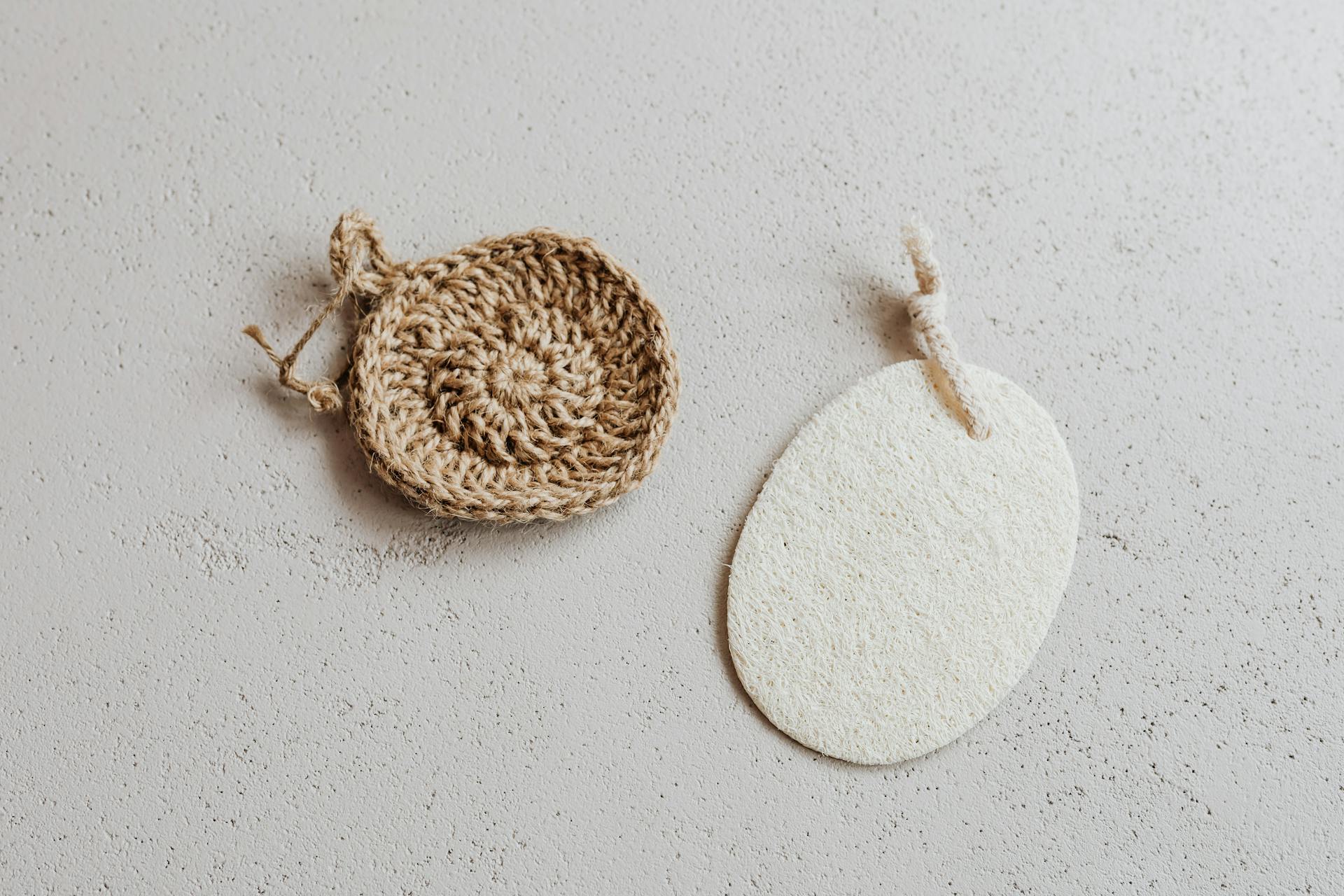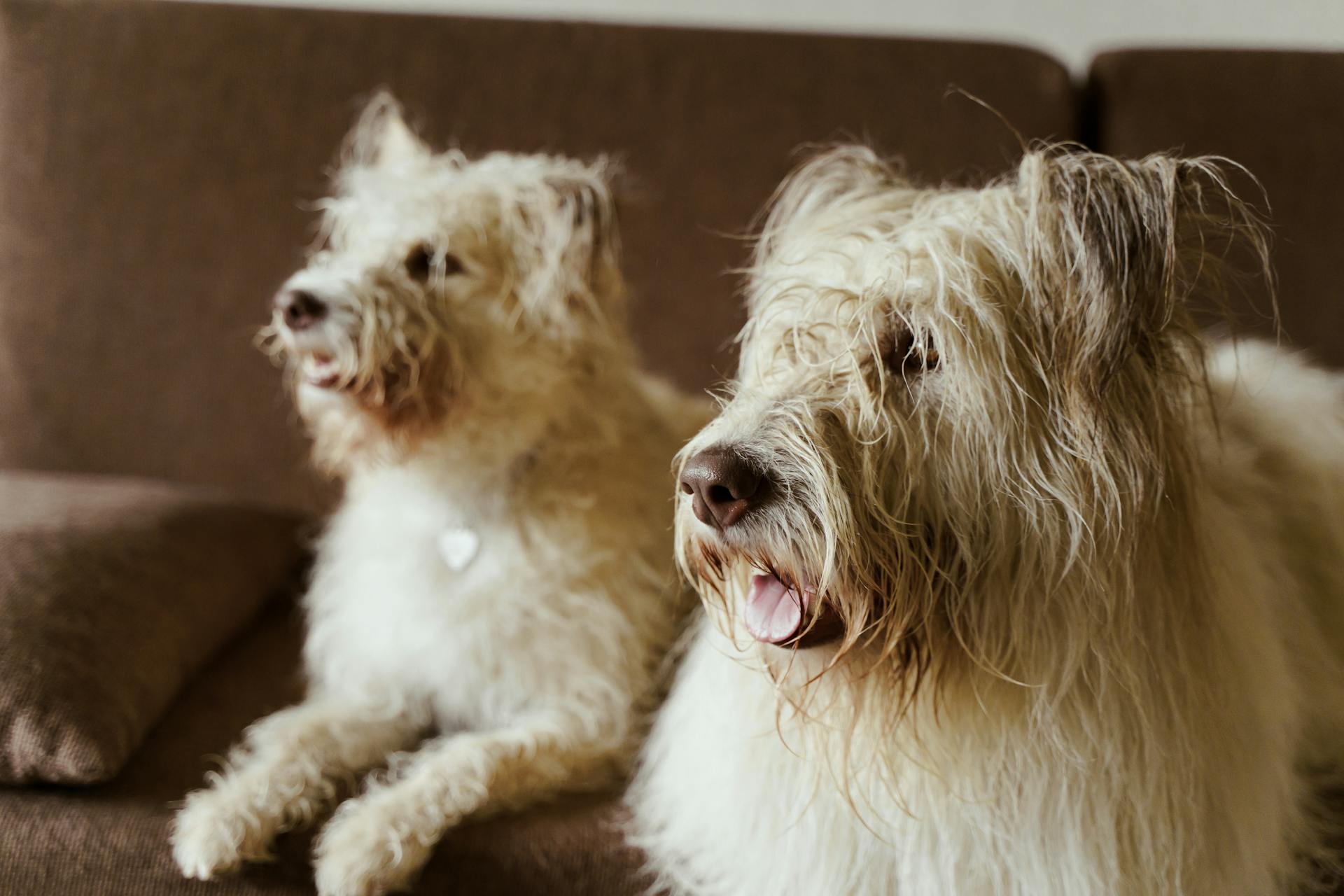
Hypoallergenic dogs are often touted as the perfect solution for people with allergies, but the truth is more complicated. Some hypoallergenic dogs shed very little, while others shed just as much as their non-hypoallergenic counterparts.
The amount of shedding in a hypoallergenic dog is influenced by its coat type. For example, dogs with curly or wavy coats, like the Bichon Frise, tend to shed very little, while dogs with single-layer coats, like the Maltese, may shed more.
While some hypoallergenic dogs shed very little, they still produce dander, which is the main culprit behind dog allergies. Dander is made up of tiny scales that fall off a dog's skin and become airborne, triggering allergic reactions in some people.
Intriguing read: Do Labradors Need Winter Coats
What Is
Hypoallergenic dogs are breeds or crossbreeds that are less likely to cause a reaction in allergy sufferers.
Hypoallergenic dogs tend to shed less, so less fur and dander are shed into the environment.
Dogs without hair or with continuously growing hair and little to no fur tend to leave the least amount of dander in the environment.
Regular grooming is a must for many hypoallergenic dogs to remove the allergenic protein from their fur.
A hypoallergenic dog's coat can be non-shedding or low-shedding, producing less dander.
Even dogs with a single coat of hair still shed, but they shed less frequently.
Hypoallergenic dogs often have curly fur, which can make them more prone to tangles if left ungroomed.
Being "hypoallergenic" doesn't necessarily mean the dog is totally allergy safe, as it simply means they are less likely to cause allergies.
Curious to learn more? Check out: Dog Blowing Coat in Winter
Factors Influencing Shedding
Seasonal temperature changes trigger seasonal shedding in dogs, causing them to lose more hair during certain times of the year.
Lifestyle plays a significant role in shedding, with indoor animals shedding less than their outdoor counterparts.
Nutrition is also crucial, as poor nutrition can lead to hair loss and excessive shedding.
On a similar theme: Short Hair Chorkie
Breed is another factor, with some breeds being more prone to shedding than others.
Hormonal status can determine hair growth phases, which can affect shedding patterns.
Pregnancy can also impact shedding, as hormonal changes can trigger hair loss.
Regular grooming is essential to reduce shedding, but it's not the only factor that influences it.
Here are some of the key factors influencing shedding in dogs:
Factors Influencing Shedding
Dogs shed for a reason - it's a natural part of their hair and fur growth. Their coats protect them from the elements and help regulate body temperature, so it's essential to have a coat that matches the season.
Dogs with double coats, which is most breeds, tend to shed seasonally, while single-coated dogs shed less frequently. This is because fur is more closely associated with the canine undercoat and sheds more heavily, leading to the spread of dander.
Some dogs, known as hypoallergenic dogs, have a single coat made of hair rather than fur, which means they shed less frequently and produce less dander. However, even these dogs still shed, just less often.
You might enjoy: Blowing Husky Coat
The frequency of shedding also depends on the type of coat your dog has. Dog hair sheds less often than fur, and dogs with both fur and hair are called double-coated dogs. Here's a quick rundown of the differences:
- Dog hair: longer, slower growth cycle, sheds less often
- Dog fur: faster growth cycle, sheds more heavily
As a dog owner, it's essential to understand the factors influencing shedding to provide the best care for your furry friend. Seasonal shedding occurs as a result of temperature change, and most dogs will shed extra during spring and fall. This process is sometimes called “blowing coats.”
Factors Influencing Behavior
Behavior can play a significant role in influencing shedding. Some dogs may exhibit anxiety or stress, leading to excessive grooming and subsequent hair loss.
Dogs that are left alone for extended periods may develop separation anxiety, causing them to excessively groom and shed. This is especially true for breeds that are prone to shedding.
Regular grooming is essential to reduce shedding, but it can also be a sign of underlying behavioral issues. If your dog is excessively grooming, it may be a sign that they're anxious or stressed.

Health conditions can also contribute to behavioral changes that affect shedding. For example, skin problems due to parasites or allergies can cause dogs to scratch and lose hair.
In some cases, behavioral changes can be a sign of underlying health issues. If you notice changes in your dog's behavior, it's essential to consult with a veterinarian to rule out any underlying health conditions.
Here are some common behavioral changes that can affect shedding:
- Excessive grooming due to anxiety or stress
- Separation anxiety leading to hair loss
- Changes in appetite or sleep patterns due to health conditions
By understanding the factors that influence behavior, you can take steps to address any underlying issues and reduce shedding.
Reducing Shedding
Visiting an allergist can help you understand the root of your allergies and determine the best course of action to alleviate them. Regular bathing and grooming of your dog, according to their coat's specific needs, can also reduce shedding.
Removing carpeting from your home can help minimize dander and reduce exposure to allergens. This is because dander tends to accumulate in carpets, making it harder to clean.
Regularly cleaning floors and surfaces throughout your home often can help reduce shedding. By doing so, you can prevent dander and allergens from accumulating and exacerbating allergies.
Here are some tips to reduce shedding:
- Bathing your dog regularly
- Grooming your dog according to their coat's specific needs
- Cleaning floors and surfaces frequently
Breed-Specific Shedding
Some dog breeds are notorious shedders, with amounts ranging from moderate to excessive. The Maltese, for example, sheds very little.
The Poodle, on the other hand, sheds very little to none, but requires regular grooming to prevent matting.
Bichon Frise
The Bichon Frise is a great choice for those who suffer from allergies. Their name is French for "fluffy white dog", and it's the ideal descriptor for these cuddly little cotton balls.
Their small size makes them a fun fit for cozy living spaces. They're also a great choice for older people because of their size and well-mannered temperament.
Bichons are playful, smart, and well-balanced, making them a great choice for a small hypoallergenic dog. They rarely shed, and most Bichon owners keep upon regular grooming to minimize this.
These dogs don’t drool either, but you might want to keep a wipe handy to make sure the fur around their mouth stays nice and bright!
Broaden your view: Great Pyrenees outside Dog
Samoyed
The Samoyed breed is a great example of how dogs can defy expectations when it comes to shedding. Samoyeds have a thick, double-layer fur coat that sheds a lot.
Their unique fur coat is actually a key factor in why they're considered hypoallergenic. Believe it or not, Samoyeds produce less dander than other breeds.
Their upturned smile isn't just cute - it also stops them from drooling, which is another common producer of allergens.
For another approach, see: Do Hypoallergenic Dogs Have Hair or Fur
Portuguese Water
Portuguese Water Dogs are big softies, and they're great hypoallergenic dogs because they don't shed their fur.
They sport a single coat of hair that continuously grows instead of fur, making them a great option for those with allergies.
Small
Small breeds like the Maltese and the Poodle are notorious shedders, producing a significant amount of hair despite their small size.
The Maltese, for example, is known to shed heavily throughout the year, with some owners reporting that they need to brush their Maltese daily to prevent matting and tangling.
A fresh viewpoint: Pitbull Mix with Small Dog
Small breeds often require regular grooming to manage their shedding, with some owners spending up to an hour a day brushing and combing their pets.
The Poodle, on the other hand, sheds very little, but requires regular grooming to prevent matting and keep their coat looking its best.
Many small breed owners find that their pets' shedding is manageable with regular brushing and grooming, but it's essential to find a routine that works for both you and your pet.
Broaden your view: Designer Dog Breeds That Are Small and Hypoallergenic
8 Best
If you're considering getting a hypoallergenic dog, you're probably wondering if they shed. The answer is yes, but with some caveats.
Hypoallergenic dogs do shed, but they produce less dander than other breeds. Dander is the main culprit behind dog allergies, so if you're looking to minimize allergy-spreading dander around the house, a hypoallergenic dog might be a good choice.
Some hypoallergenic breeds have curly coats, like Poodles, which are known for their low-shedding texture. Poodles come in a range of sizes, from Toy to Standard, and are often mixed with other breeds to create a hypoallergenic "doodle".
Regular brushing and grooming are essential for keeping a hypoallergenic dog's coat smooth and knot-free, which can help reduce dander. We recommend brushing non-allergy dogs daily to keep their coats in top condition.
Here are some of the best hypoallergenic dog breeds that might be the paw-fect fit for your furry family:
Doodle Breeds
Doodle Breeds are a popular choice for those with allergies, and for good reason. Poodles are the foundation of many hypoallergenic breeds, known for their low-shedding coats.
Poodles are often mixed with other breeds to create a hypoallergenic "doodle" that doesn't shed. These mixes include Goldendoodles, Labradoodles, and many more.
Some popular Poodle mixes include Goldendoodles, Labradoodles, Bernedoodles, Aussiepoos, Schnoodles, Cockapoo, Maltipoo, and Cavapoo. Each of these breeds combines the low-shedding coat of a Poodle with the characteristics of another breed.
Regardless of the breed, frequent vacuuming, cleaning, and baths can help keep allergies at bay.
Suggestion: Hypoallergenic Doodle Dogs
Breeds to Avoid
If you're allergic to dogs, it's best to avoid breeds that shed a lot.
Labrador Retrievers, for example, are notorious shedders and should be avoided if you have allergies.
Golden Retrievers are another breed that sheds heavily, making them a poor choice for those with allergies.
German Shepherds are highly energetic and shed a lot, which can exacerbate allergies.
Pekingese and Pugs are also known to be heavy shedders, making them a no-go for those with allergies.
Here are some breeds to avoid if you're allergic to dogs:
- Labrador Retriever
- Golden Retriever
- German Shepherd
- Pekingese
- Pug
Frequently Asked Questions
What is so special about hypoallergenic dogs?
Hypoallergenic dogs produce less dander and shed less, making them a great option for those with allergies. This is due to their hair-like coat, which traps dander instead of releasing it into the air.
Do hypoallergenic dogs still cause allergies?
Yes, hypoallergenic dogs can still cause allergic reactions, as they produce allergens that become airborne, especially when they groom themselves. Despite their name, no dog breed is completely allergy-safe.
What dog is 100% hypoallergenic?
Unfortunately, there is no dog breed that is 100% hypoallergenic, but some breeds are less likely to trigger allergies due to producing less dander and saliva. If you're looking for a low-allergenic dog, consider learning more about breeds that are considered hypoallergenic-friendly.
What dog is the most hypoallergenic?
The Poodle is generally considered the most hypoallergenic dog breed due to its low-shedding, curly coat. However, other breeds like the Portuguese Water Dog and the Bichon Frise also have low-shedding coats that may be suitable for those with allergies.
Sources
- https://www.sunvetanimalwellness.com/2019/10/dog-shedding-causes-remedies/
- https://www.goodhousekeeping.com/life/pets/g4503/dogs-that-dont-shed/
- https://blackhawkpetcare.com/nz/articles/hypoallergenic-dog-breeds/
- https://spotpet.com/blog/breed-tips/hypoallergenic-dog-breeds
- https://www.thesprucepets.com/hypoallergenic-dog-breeds-5181208
Featured Images: pexels.com


